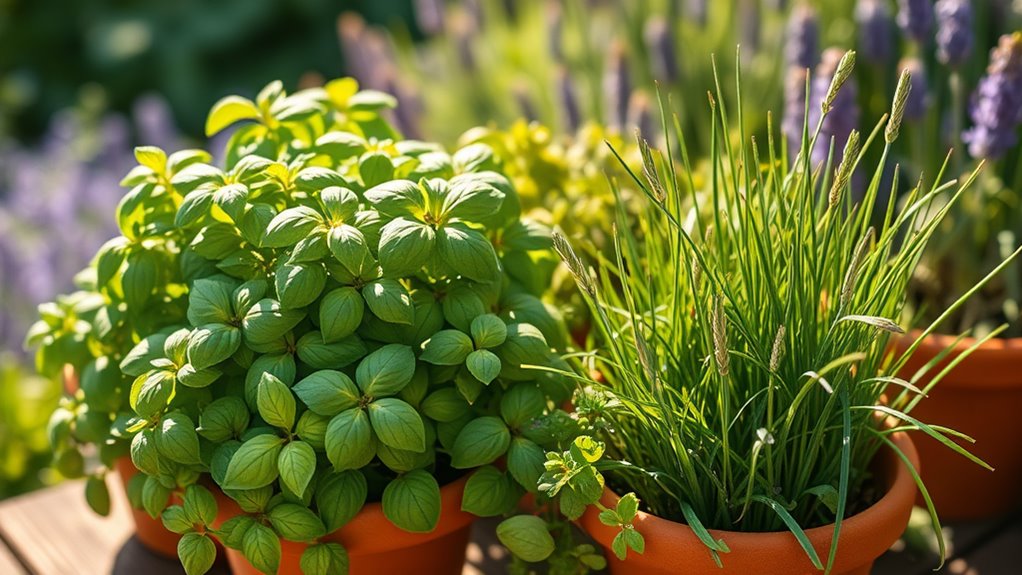The Herbs You’ll Wish You Started Growing Sooner
Key Takeaways
- Basil’s aromatic qualities enhance a variety of dishes, making it a must-grow for any kitchen enthusiast.
- Mint’s invigorating scent and flavor elevate drinks and desserts, ensuring your garden feels fresh and lively.
- Rosemary’s fragrant leaves not only boost flavors but also offer antioxidant benefits, perfect for Mediterranean dishes.
- Chives add a mild onion flavor to meals and are easy to grow with health-boosting vitamins.
- Cilantro’s bright taste is essential for enhancing salsas and curries, enriching your culinary experiences with freshness.
Basil: The Versatile Kitchen Staple
Embracing the aromatic allure of basil can transform your culinary creations into vibrant dishes that tantalize the senses.
Indoor herb gardening makes it easy to cultivate this versatile staple. With just a sunny windowsill and well-drained soil, you’ll enjoy fresh basil for salads, pasta, and sauces.
Regular trimming encourages bushy growth, ensuring that every meal bursts with flavor and freshness. Incorporating fresh basil into your diet may also support gut health by providing essential nutrients and antioxidants.
Mint: A Refreshing Addition to Your Garden
After enjoying the vibrant flavors of basil, consider adding mint to your herb garden for a revitalizing twist. Mint’s fresh, invigorating scent and flavor can elevate dishes, drinks, and even desserts. Plus, it’s easy to grow! Here’s a quick overview:
| Uses | Varieties | Care Tips |
|---|---|---|
| Tea & cocktails | Spearmint | Water regularly |
| Salads | Peppermint | Full sun |
| Desserts | Chocolate mint | Prune often |
Rosemary: The Fragrant Heirloom Herb
Rosemary’s aromatic leaves can elevate your culinary creations, transforming everyday dishes into gourmet experiences. As you explore the art of growing this heirloom herb, you’ll discover tips for caring for it that guarantee robust flavor and vigor. Rosemary is known for its medicinal properties, making it not just a flavorful addition to your kitchen but also a potential natural remedy. Get ready to infuse your meals with this fragrant delight while cultivating a resilient plant in your garden!
Culinary Uses and Benefits
Although many herbs elevate a dish’s flavor, rosemary stands out with its robust aroma and versatile culinary applications.
You can enhance meats, particularly lamb and chicken, with its distinctive taste. Rosemary’s earthy essence beautifully complements roasted vegetables and hearty stews.
Additionally, infuse oils or vinegar for delightful dressings. Its antioxidant properties further boost your meals, making every bite not only flavorful but beneficial.
Growing and Caring Tips
To successfully grow rosemary, it’s essential to understand its love for warm climates and well-draining soil.
Plant your rosemary in a sunny spot, aiming for at least six hours of sunlight daily.
Water it deeply but infrequently to prevent root rot.
Pruning encourages bushier growth, so don’t be shy about snipping.
With proper care, your rosemary will thrive, rewarding you with its delightful fragrance and flavor.
Chives: The Easy-to-Grow Garnish
Chives are a fantastic herb to grow, offering robust flavor and a beautiful green touch to your dishes.
They thrive in various conditions, making them an ideal choice for novice gardeners.
Plus, with their culinary versatility, chives can elevate everything from soups to salads while delivering essential nutrients that benefit your health.
Growing Conditions for Chives
If you want to cultivate a flourishing chive garden, you’ll need to provide the right growing conditions that encourage their vibrant growth.
Chives thrive in well-drained, loamy soil and prefer full sun to partial shade. Keep the soil consistently moist, but not soggy.
For peak growth, maintain a temperature between 60°F to 75°F. Regularly harvesting encourages fresh, new growth, ensuring a bountiful supply.
Culinary Uses and Benefits
While you might think of chives as just a simple garnish, their culinary uses and benefits extend far beyond mere decoration on your plate.
These vibrant herbs add a fresh, mild onion flavor to salads, soups, and dips. Packed with vitamins A and C, they boost your immune system too.
With their easy growth, you’re missing out if you haven’t started cultivating chives yet!
Cilantro: A Flavorful Culinary Delight
Cilantro, often hailed as a culinary star, brings a burst of vibrancy to dishes that few herbs can match. From salsas to stir-fries, its vibrant flavor awakens the senses. Check out its versatile uses below:
| Dish Type | Fresh Use | Cooked Use |
|---|---|---|
| Salsas | Enhances flavor | Can be added post-cooking |
| Soups | Garnish for visual appeal | Stir in for depth |
| Salads | Adds a rejuvenating touch | Lightly cooked for warmth |
| Tacos | Essential topping | Infuses during cooking |
| Curries | Brightens the dish | Balances spices |
Thyme: A Hardy Herb for Year-Round Use
Thyme, with its resilient nature and aromatic profile, easily adapts to various culinary styles, making it a must-have for any herb garden.
This hardy herb thrives in diverse conditions, providing a rich depth to soups, stews, and roasted dishes.
Just a few snips from your garden can elevate your meals, and its flavor only intensifies with drying, ensuring year-round enjoyment.
Oregano: The Mediterranean Must-Have
If you’re creating a diverse herb garden, oregano should definitely make your list. Its robust flavor elevates Italian dishes, and it’s rich in antioxidants.
Oregano thrives in well-drained soil and sunny spots, making it easy to cultivate. Plus, fresh leaves pack a punch in sauces, marinades, and salads. You’ll find yourself reaching for this Mediterranean staple more than you’d expect!

